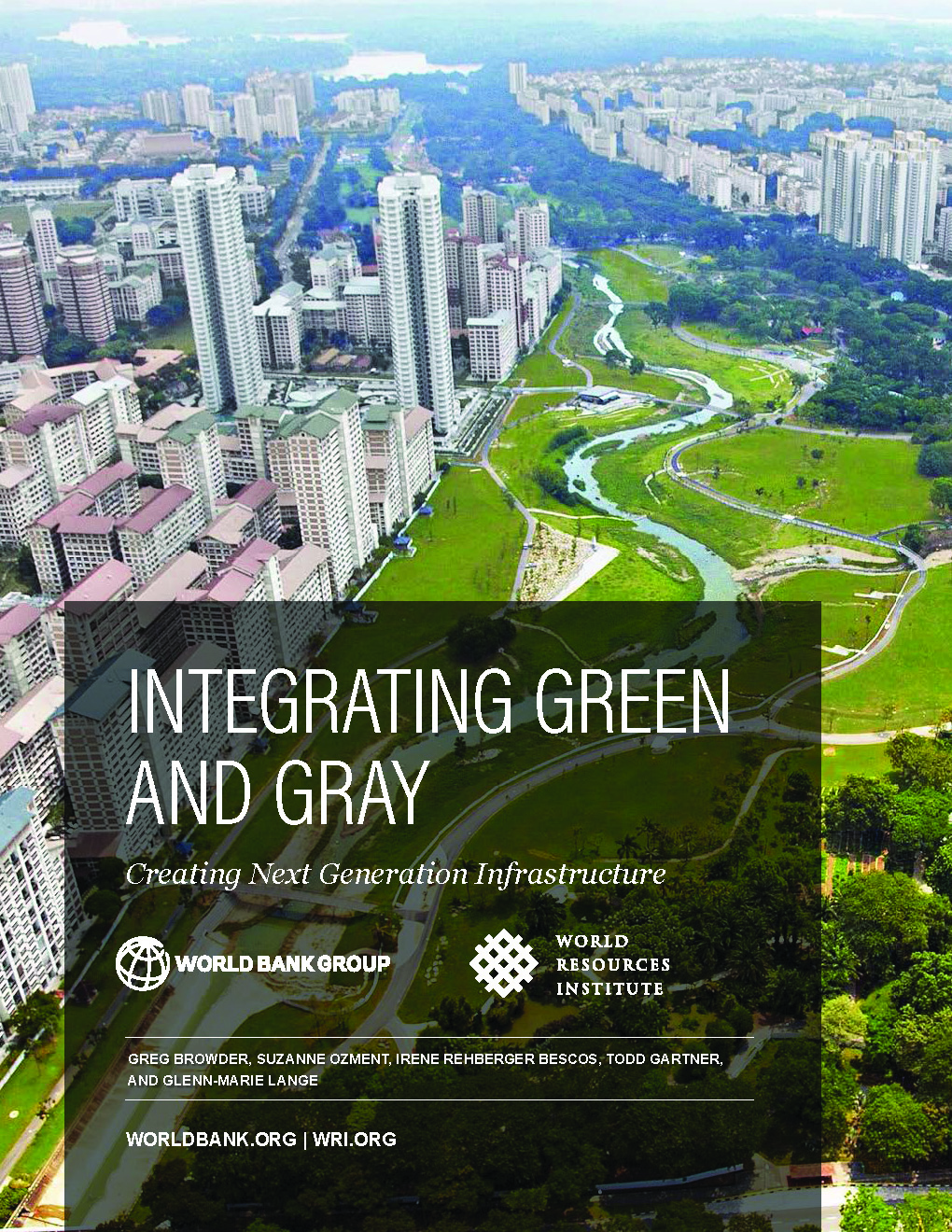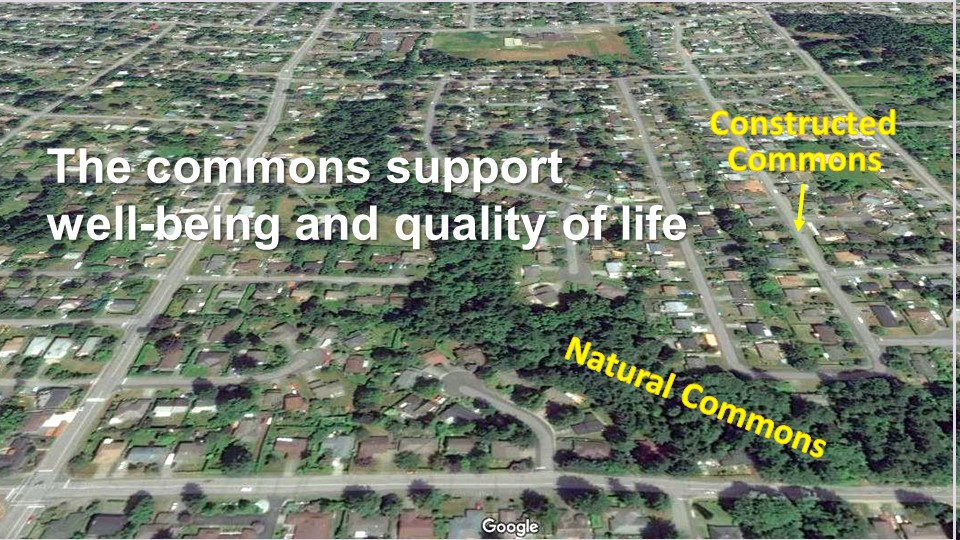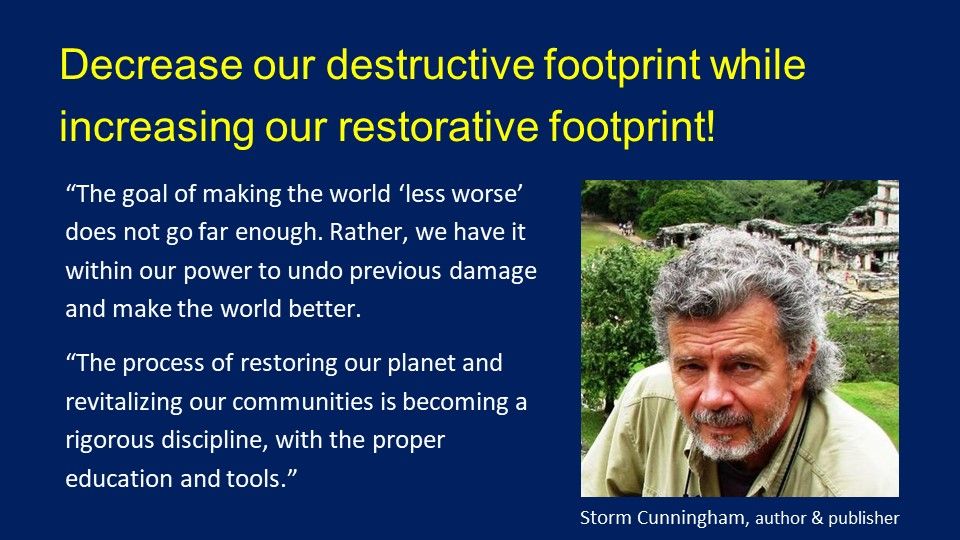JUST RELEASED (March 2019): “Integrating Green and Gray – Creating Next Generation Infrastructure” – joint report by World Bank and World Resources Institute states that the next generation of infrastructure can help drive economies and strengthen communities and the environment
Note to Reader:
Released in March, “Integrating Green and Gray – Creating Next Generation Infrastructure” is a joint report from the World Bank and the World Resources Institute (WRI) that aims to advance the integration of green and gray infrastructure solutions on the ground.
Inspirational in its call to action, the report states that the next generation of infrastructure can help drive economies and strengthen communities and the environment. But this needs governments, the stewardship sector and service providers to work together to amplify the benefits of natural solutions.
 The main thrust of this landmark document mirrors the pioneer work of Storm Cunningham, US-based author of The Restoration Economy and several other books, including the soon-to-be-published RECONOMICS: The Path to Resilient Prosperity. Earlier in April, Storm Cunningham visited British Columbia to deliver two public lectures on this theme: Nature is Regenerative: We Should Be Too.
The main thrust of this landmark document mirrors the pioneer work of Storm Cunningham, US-based author of The Restoration Economy and several other books, including the soon-to-be-published RECONOMICS: The Path to Resilient Prosperity. Earlier in April, Storm Cunningham visited British Columbia to deliver two public lectures on this theme: Nature is Regenerative: We Should Be Too.
The report also aligns with the vision and guiding principles for the Ecological Accounting Process (EAP), an initiative led by the Partnership for Water Sustainability in British Columbia. The ‘big idea’ underpinning EAP is that community well-being and quality of life depend on an equal commitment to the natural commons and constructed commons. This is the essence of a whole-system approach.
“Integrating Green and Gray – Creating Next Generation Infrastructure” places a spotlight on the world’s growing infrastructure crisis, driven by climate change and growing populations. It proposes insights, solutions and examples for putting nature to work. It examines the technical, environmental, social and economic dimensions of a typical project assessment but also outlines, with new clarity and detail, the enabling conditions required to facilitate successful implementation of green-gray projects.
Harnessing the collective analytical and technical expertise of the World Bank and WRI, the report aims to build momentum in both policy and practice. In British Columbia, a provincial catalyst for local governments to embrace and implement nature-based solutions is Asset Management for Sustainable Service Delivery: A BC Framework.

DESIGN WITH NATURE TO ADAPT TO A CHANGING CLIMATE:
“If we help nature, then nature can help us – that’s the message of this report,” said Kristalina Georgieva, Interim President, World Bank Group
Nature-based Solutions
A new generation of infrastructure projects that harness the power of nature can help achieve development goals, including water security and climate resilience, according to a new report from the World Bank and World Resources Institute. Both organizations are calling for green infrastructure to play a bigger role in traditional infrastructure planning.
Integrating Green and Gray – Creating Next Generation Infrastructure shows how weaving the power of ‘green’ natural systems, including flood plains and forests, into ‘gray’ traditional infrastructure systems can lower cost and increase resilience.
 “If we help nature, then nature can help us – that’s the message of this report,” said Interim President (Feb 2019 through April 2019) of the World Bank Group Kristalina Georgieva. “Measures like replanting wetlands can shield cities from storms and flooding, and protecting forests improves watersheds. Infrastructure should make use of plants and nature to boost resilience and create a more livable environment.”
“If we help nature, then nature can help us – that’s the message of this report,” said Interim President (Feb 2019 through April 2019) of the World Bank Group Kristalina Georgieva. “Measures like replanting wetlands can shield cities from storms and flooding, and protecting forests improves watersheds. Infrastructure should make use of plants and nature to boost resilience and create a more livable environment.”
The report illustrates how emerging technology such as earth-based observations and advanced modelling make it cheaper and easier to design and assess the performance of green infrastructure. It also lays out a new framework for practitioners and service providers to integrate green infrastructure into gray, including technical, environmental, social, and economic dimensions.
The report finds that integrating green and gray infrastructure can help deliver a “triple-win” with benefits for the economy, communities, and the environment.
To Learn More:
Watch the report launch:
Rising to 21st Challenges
 “21st century challenges require innovative solutions and utilizing all the tools at our disposal,” states Greg Browder, World Bank Global Lead for Water Security & Lead Author. “And integrating ‘green’ natural systems like forests, wetlands and flood plains into ‘gray’ infrastructure system shows how nature can lie at the heart of sustainable development. Integrating Green & Gray – Creating Next-Generation Infrastructure provides guidance on how to do just that.”
“21st century challenges require innovative solutions and utilizing all the tools at our disposal,” states Greg Browder, World Bank Global Lead for Water Security & Lead Author. “And integrating ‘green’ natural systems like forests, wetlands and flood plains into ‘gray’ infrastructure system shows how nature can lie at the heart of sustainable development. Integrating Green & Gray – Creating Next-Generation Infrastructure provides guidance on how to do just that.”
Green Infrastructure – A Way to Meet the Infrastructure Investment Gap
 “Green infrastructure can be cheaper and more resilient than gray infrastructure alone—and it can produce substantial benefits beyond what the balance sheets measure,” states Andrew Steer, President and CEO, World Resources Institute. “These nature-based solutions can help us meet the infrastructure investment gap in a cost-effective manner, while lifting up local communities with benefits in their backyards. We’re at a climate inflection point, and in the midst of an infrastructure crisis. Now more than ever, the world must tap into nature’s wealth.”
“Green infrastructure can be cheaper and more resilient than gray infrastructure alone—and it can produce substantial benefits beyond what the balance sheets measure,” states Andrew Steer, President and CEO, World Resources Institute. “These nature-based solutions can help us meet the infrastructure investment gap in a cost-effective manner, while lifting up local communities with benefits in their backyards. We’re at a climate inflection point, and in the midst of an infrastructure crisis. Now more than ever, the world must tap into nature’s wealth.”

Ecological Accounting Process (EAP) – Nature cannot be sliced and diced to suit land development
The Ecological Accounting Process (EAP) provides metrics that enable communities to appreciate the worth of natural assets. These resources provide numerous public benefits in the form of ecological services. EAP also calculates the dollar value of the land occupied by the natural commons, thus providing a basis for budgeting maintenance and enhancement expenditures.
Also, EAP findings can contribute to strategy and plans for asset management. As illustrated above, the natural commons has a corollary – namely, the constructed commons. In all communities, the constructed commons utilizes ecological systems for aesthetic purposes and infrastructure needs; and the constructed commons benefits from the ambience of ecological services. Yet the worth of ecological services remain obscure in land use practices.


